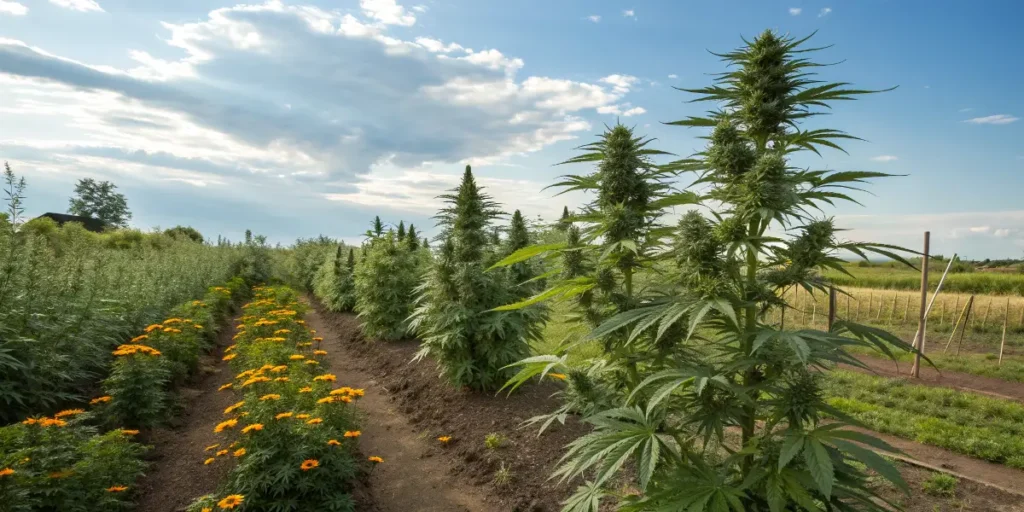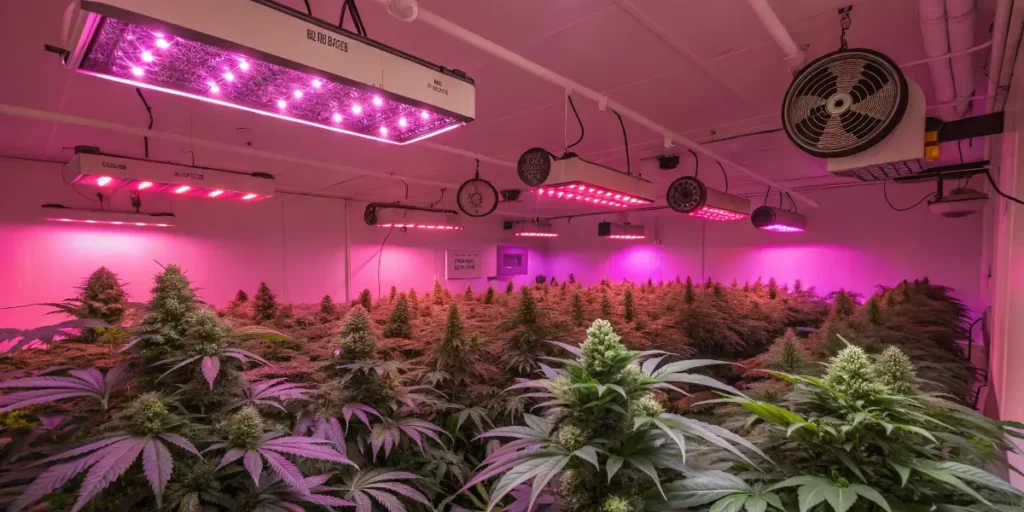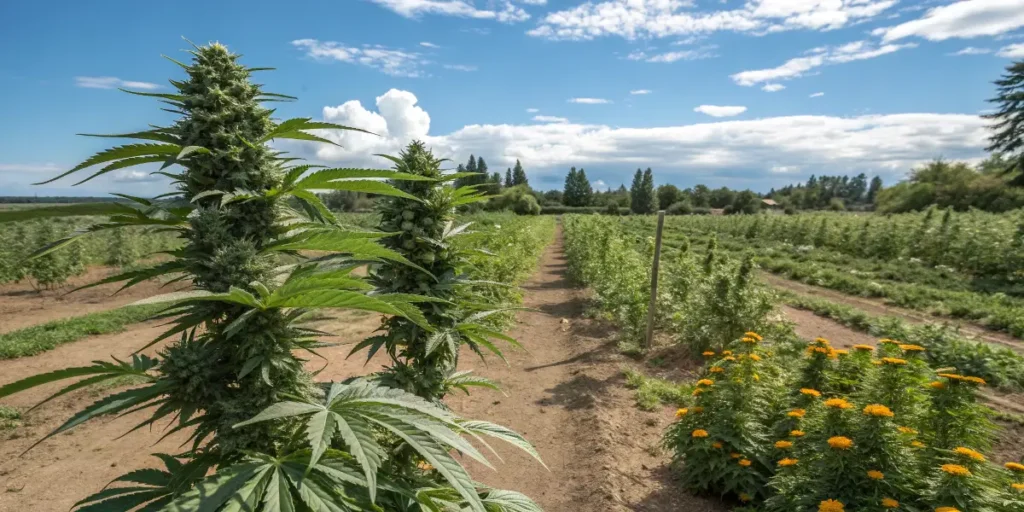The Cheese strain, known for its pungent aroma and distinctive flavor profile, is a beloved variety among cannabis enthusiasts. Its origins can be traced back to the United Kingdom in the late 1980s, and it quickly gained popularity due to its unique taste and relaxing effects. Successfully cultivating this strain requires attention to detail, optimal growing conditions, and patience. In this guide, we’ll walk you through the steps necessary to grow healthy and bountiful Cheese plants.
First and foremost, select high-quality seeds from a reputable supplier. This strain is feminized, which means they eliminate the guesswork of identifying and removing male plants. Start by germinating the seeds using a reliable method, such as the paper towel technique. Place moist paper towels in a container or plastic bag, insert the seeds, and maintain a warm environment until they sprout. Ensure the paper towels remain damp, but not overly wet, to prevent mold.
Once the seeds have sprouted, it’s time to plant them in a suitable growing medium. Choose a high-grade potting mix or a specialized soil blend that promotes drainage and root health. This strain thrives in both indoor and outdoor environments, but controlling indoor conditions provides the most consistent results. Maintain indoor temperatures between 70-80°F (21-27°C) and humidity levels around 40-50% during the vegetative stage. Proper lighting is crucial; employ LED or high-pressure sodium lights to mimic natural sunlight.
When transitioning to the flowering stage, adjust the light cycle to 12 hours of light and 12 hours of darkness. This change signals the plant to start producing buds. During flowering, Cheese plants may exude a strong aroma. Ensure your growing area is well-ventilated with a carbon filter to manage the odor. Regularly prune your plants to improve airflow and light penetration, which reduces the risk of mold and pests.
Nutrient management is a key component in cultivating Cheese plants. During the vegetative stage, focus on fertilizers high in nitrogen. As the plant enters the flowering stage, gradually decrease nitrogen levels and increase phosphorus and potassium to support bud development. Monitor pH levels closely, keeping them within the range of 6.0 to 6.5 for optimal nutrient uptake.
The harvest is an exciting stage after weeks of dedicated care. Watch for signs that your Cheese plants are ready, such as pistil color change and trichome development. Harvesting at the right time will preserve the strain’s renowned flavor and potency. After harvesting, cure the buds by drying them slowly in a controlled environment for two to three weeks. This process enhances the flavor and ensures a smooth smoking experience.
Cheese Strain Strain Overview: Traits, Effects & Genetics
The Cheese strain, a classic in the cannabis world, has garnered acclaim for its unique attributes and memorable sensory profile. Originating in the United Kingdom, this strain is a phenotype of Skunk #1, and it’s renowned for its distinctive cheese-like aroma. Cultivators and consumers alike are drawn to its potent aroma, which is both pungent and earthy with sharp, cheddar-like undertones. The strain’s buds are typically dense and coated with a lush layer of trichomes, providing a visual cue of its potency. Its coloration is a vibrant mix of deep greens interspersed with orange pistils, making for an appealing visual aspect.
As for its effects, Cheese is well-loved for its balanced impact on both mind and body. It offers a euphoric, uplifting cerebral high, often leading to fits of laughter and creative energy, making it ideal for social settings. Yet, despite its invigorating edge, Cheese also imparts a profound relaxation that permeates through the body, which can help relieve stress and tension. Medical users have noted the strain’s ability to alleviate chronic pain, insomnia, and symptoms of depression, thanks to its comforting and mood-boosting qualities. The potency of its effects can vary but generally hovers around a moderate tetrahydrocannabinol (THC) content, suitable for both novice and experienced users.
Genetically, Cheese draws from robust roots that explain its resilient nature and consistent profile. As a descendant of Skunk #1, it retains the hardiness and high yield potentials characteristic of skunk plants. The selective breeding of Skunk #1 has endowed Cheese with a relatively quick flowering time and adaptability to both indoor and outdoor growing environments. Typically, the strain matures within 8 to 9 weeks and is sought-after for its generous yield and straightforward cultivation, making it a favorite amongst home-grow enthusiasts and commercial cultivators. Its rich lineage, coupled with its steadfast performance, ensures that this strain remains a staple in cannabis gardens worldwide.
To sum up, the Cheese strain stands out as a compelling option for those seeking an aromatic, balanced cannabis experience. With its unique traits, versatile effects, and resilient genetics, Cheese continues to be a sought-after strain that offers both recreational and medicinal benefits. Its enduring popularity speaks volumes about its ability to captivate and satisfy the global cannabis community.
Optimal Environment to Grow Cheese Strain Successfully
The Cheese strain, a renowned cannabis variety known for its distinct aroma and generous yield, thrives in an environment that mimics its natural growing conditions. Temperature and humidity play crucial roles in the effective cultivation of this strain. Ideally, this strain flourish in a warm climate where daytime temperatures range between 70°F to 85°F (21°C to 29°C). Nighttime temperatures should be slightly cooler, but not drop below 60°F (15°C) to prevent any growth stalling or stress that could affect the plant’s health and yield.
Humidity levels are equally important and should be adjusted according to the plant’s growth stage. During the vegetative phase, maintaining a higher humidity level of around 60% is beneficial as it promotes healthy leaf growth and overall plant vitality. As the plants transition into the flowering phase, it’s essential to lower the humidity to about 40% to 50% to prevent mold and bud rot, which are common issues in dense budding strains like Cheese. Good air circulation is key to managing humidity levels effectively, so incorporating oscillating fans can help distribute air evenly throughout your grow space.
Lighting conditions also play a critical role in achieving the optimal growth environment. This strain prefers consistent light exposure during its vegetative stage, with 18 to 24 hours of light. As it moves into the flowering period, a 12/12 light cycle, mimicking natural sunlight exposure, encourages robust flowering. When it comes to choosing the appropriate grow lights, full-spectrum LED or high-intensity discharge (HID) lamps are often recommended, as they provide the necessary light intensity for dense bud production and excellent terpene profiles.
Besides temperature, humidity, and lighting conditions, the medium in which Cheese strain is grown and its nutrient intake are pivotal components of the growing environment. This strain flourishes in a well-draining soil mix that retains adequate moisture, with a pH level maintained between 6.0 to 6.5 for optimal nutrient absorption. Regularly monitoring the pH and investing in quality fertilizers designed for cannabis can significantly enhance the growth potential and health of your Cheese plants, ensuring they produce the vibrant, aromatic yields the strain is known for.
Grow Room Setup for Cheese Strain Plants
Cheese strain, known for its unique aroma and robust growth characteristics, thrives in a well-planned grow room setup. To maximize yield and potency, it’s essential to simulate a balanced environment that caters to the plant’s specific needs. Start by ensuring your grow room is equipped with proper ventilation. This strain is particularly sensitive to high humidity, which can attract mold and pests. Using oscillating fans and exhaust systems will help maintain airflow, keeping humidity levels in check and ensuring fresh air is circulated effectively.
Lighting is a crucial component of your grow room setup. This plants require a consistent light schedule to flourish. During the vegetative stage, employ a cycle of 18 hours of light followed by 6 hours of darkness. When transitioning to flowering, switch to 12/12 lighting. LED lights are recommended as they provide optimal energy efficiency and promote healthy plant development without generating excessive heat, which could stress the plants. Position the lights strategically to cover the entire canopy, allowing even light distribution.
The choice of growing medium and nutrient regimen plays a significant role in cultivating this strain successfully. Opt for a well-draining soil mix or hydroponic system, supplemented with an appropriate nutrient solution tailored for cannabis. This strain typically favor a balanced NPK (nitrogen, phosphorus, potassium) ratio but remain vigilant for signs of nutrient deficiencies or excess. Conduct regular water pH level checks to ensure it stays within the ideal range of 5.8 to 6.5, as this affects nutrient uptake and overall plant health.
Temperature control is another pivotal factor in ensuring robust cheese strain growth. Maintain a temperature range of 70°F to 80°F (21°C to 27°C) during the plant’s light cycle. Lower the temperature by a few degrees during the dark period to mimic natural conditions. If possible, use climate control systems to sustain these parameters, particularly in varying weather conditions. Consistent temperatures not only aid in plant metabolism but also contribute to achieving the dense bud structure characteristic of this strain.
Indoor Growing Tips for Cheese Strain
This strain, renowned for its distinctive aroma and powerful effects, requires some specific conditions when cultivated indoors. Firstly, maintaining a stable indoor environment is crucial. Cheese thrives in a climate-controlled setting where temperature and humidity levels can be carefully monitored. Ideally, maintain temperatures around 70-80°F (21-27°C) during the day and slightly lower at night. Relative humidity should be adjusted through the growing phases, starting around 70% during the seedling stage and gradually lowering to 40% during flowering to prevent mold and mildew.
Lighting is another pivotal factor for growing the Cheese strain indoors. Given its indica-dominant genetics, the plant can benefit from high-efficiency LED grow lights that mimic the full spectrum of sunlight. These lights should be positioned at an appropriate distance to prevent burning the plant, as Cheese plants can be light-sensitive. Implement an 18/6 light schedule during the vegetative stage for optimal growth, reducing it to 12/12 during flowering to stimulate bud development.
When it comes to nutrition, Cheese plants have specific feeding requirements. During the vegetative phase, the plant benefits from high nitrogen content in its nutrient mix, which supports leaf production. As the plant transitions to the flowering phase, adjust the nutrient profile to lower nitrogen and increase phosphorus and potassium levels to encourage robust bud growth. Organic nutrients or quality hydroponic solutions often yield the best results, enhancing the strain’s flavor and aroma profile.
Outdoor Growing Tips for Cheese Strain
The Cheese strain, renowned for its robust aroma and potent effects, is a popular choice for outdoor cultivators. Successfully growing Cheese outdoors starts with selecting the right location. This strain thrives in a sunny environment, so choose a spot that receives ample sunlight throughout the day. Good air circulation is also crucial, which helps prevent mold and pest infestations. Don’t forget the importance of discretion in this process, since the strong smell of growing cannabis can attract unwanted attention.
When it comes to soil preparation, Cheese plants prefer a nutrient-rich medium. Consider enhancing your soil with organic compost to ensure adequate nutrition. Additionally, maintaining the right pH balance, ideally between 6.0 and 7.0, is essential for optimal nutrient absorption. Invest in a reliable pH meter to regularly check and adjust the soil’s acidity or alkalinity. It’s also beneficial to augment the soil with perlite or vermiculite, which enhances drainage and allows the roots to breathe properly.
Regular watering is a must, especially during dry spells. Cheese plants prefer consistent, moderate watering to avoid over-saturation. Deep watering helps encourage root growth but be mindful to let the topsoil dry out between waterings to prevent root rot. It’s worth installing a drip irrigation system to deliver the moisture more efficiently and reduce water waste. Keep a vigilant eye on the weather, and prepare to water more heavily during particularly hot periods.
Pest management is another critical aspect of outdoor growing. Cheese plants can be susceptible to common cannabis pests like aphids and spider mites. Consider using organic pesticides and companion planting—growing pest-repelling plants like marigolds nearby can be beneficial. Regularly inspect your plants for early signs of infestation and act quickly to manage any issues. With the right care and conditions, Cheese can provide a prolific outdoor harvest and delight growers with its rich, cheesy aroma and potent effects.

How to Germinate & Propagate Cheese Strain
The Cheese strain, beloved for its distinctive aroma and potent effects, is a favorite among cannabis growers. Germination, the process of sprouting seeds, is the first crucial step in cultivating this strain. To germinate Cheese seeds, you need to start with quality seeds, which significantly impacts the success rate. Begin by soaking the seeds in a glass of room temperature water for about 12 to 24 hours. This softens the outer shell and promotes the initiation of the germination process. Once you see the seeds showing a small taproot, usually after 24 to 48 hours, they are ready for the next phase.
Moisture, warmth, and darkness create the optimal conditions for germination. Transfer the soaked seeds to a damp paper towel, ensuring it’s not overly wet as excessive moisture can lead to mold formation. Place the paper towel with seeds on a plate and cover it with another plate or wrap it in a plastic bag to maintain humidity. Store the setup in a warm, dark place such as a cupboard. The ideal temperature for germinating Cheese seeds is between 70 to 85 degrees Fahrenheit. Check daily to ensure the paper towel retains moisture.
As the small taproots emerge, it’s time to prepare them for propagation. Fill small pots or seedling trays with quality starter soil or a seedling mix. Make small holes, roughly half-inch deep, and gently place the germinated seeds taproot-downward into the soil, covering them lightly. Keep the soil moist but not saturated and continue to provide warmth. Once seedlings emerge, transfer them to a grow space where they can receive adequate light—ideally, 18 hours of light and 6 hours of darkness. This environment encourages strong growth in the early vegetative stage.
Propagation can also be achieved through cloning, which ensures the replica of the parent Cheese plant’s characteristics. To clone, select a healthy mother plant and cut a 4-6 inch long branch from the top. Remove the leaves from the lower half and dip the cutting’s end in a rooting hormone. Plant the cutting in a damp growing medium and cover it with a plastic dome or use a cloning machine to maintain humidity levels around 70-80%. Keep the clones under fluorescent lighting until root development occurs. Regularly check for moisture and condensation to ensure a conducive growth environment.
Successful germination and propagation of Cheese strain result in robust plants that will eventually yield aromatic and potent buds. By maintaining optimal conditions during these stages and monitoring environmental factors such as temperature, humidity, and lighting, growers can enhance their chances of a fruitful harvest. Recognizing these foundational steps sets the pathway for a healthy and thriving cannabis garden.
Vegetative Stage
The vegetative stage is a critical phase in the growth of Cheese strain cannabis plants. During this stage, the plants focus on developing strong roots and lush foliage, preparing for a robust flowering period. Optimal light and nutrient management are key. Cheese plants thrive under light schedules with at least 18 hours of light per day. This extended daylight exposure stimulates vigorous growth and allows the plants to fully develop their structural potential. High-quality grow lights or access to natural sunlight will ensure they receive the essential energy required for photosynthesis.
Providing the right nutrients at this stage is important. This plants require a higher nitrogen concentration during the vegetative stage to support healthy leaf and stem development. Utilize a balanced N-P-K (Nitrogen-Phosphorus-Potassium) fertilizer formulated for the vegetative phase. Regularly monitor the pH levels of the growing medium to ensure nutrient uptake isn’t disrupted. Aim for a pH of 6.0 to 6.8 for soil and 5.5 to 6.5 for hydroponic systems. Any deviations in these levels may cause nutrient lockout, hindering growth and vitality.
Besides light and nutrients, environmental factors such as humidity and temperature play a crucial role. During the vegetative stage, aim to maintain temperatures between 70-85°F (20-29°C). Relative humidity levels should be kept between 40-70%. This range supports optimal transpiration rates and prevents issues such as mold or mildew, which can be detrimental to plant health. Good air circulation can be beneficial in maintaining consistent humidity and temperature levels while also strengthening plant stems.
Pruning and training are beneficial techniques during the vegetative stage that encourage bushier growth and allow for more even canopy development. Techniques such as topping or using a Screen of Green (ScrOG) method may help in managing plant height and optimizing light exposure across all foliage. Besides , consistently monitoring for any signs of pests or diseases and taking swift action if detected will preserve plant health during this crucial stage. Following these guidelines will set the foundation for a fruitful flowering phase and ultimately lead to a rewarding Cheese strain harvest.
Flowering Cheese Strain: What to Expect
The cheese strain, known for its unique aroma and potent effects, is a favorite among cannabis cultivators. When focusing on the flowering phase, growers of this strain should anticipate a span of approximately 8 to 10 weeks, though this can slightly vary based on growing conditions and specific strain variants. During this period, cultivators can expect the plant to significantly increase in size and its characteristic creamy, musky scent to intensify. The resilience of this strain makes it suitable for both indoor and outdoor cultivation, offering versatility to growers.
One of the most notable aspects of this strain during its flowering stage is the development of dense, resinous buds. These buds are typically coated with a generous dusting of trichomes, which contributes to its standout potency. Expect the branches to become notably heavy, and growers might need to provide additional support to prevent the branches from bending or breaking under the weight of the dense flowers. Implementing support structures early in the flowering stage can help manage this growth and maintain plant health.
As harvest time approaches, cultivators should closely observe the trichomes’ color and clarity. For this strain, optimal harvesting time is often when most trichomes turn a milky white, with some beginning to shift to an amber hue, indicating peak potency and flavor profile. Attention to environmental factors such as humidity and temperature is crucial during this stage to prevent mold or mildew from developing on the densely packed flowers. Controlling these conditions ensures the cheese strain retains its signature quality and robust terpene profile, delivering the full aromatic and psychoactive experience typical of this beloved variety.
Throughout the flowering stage, it’s essential to maintain a balanced nutrient regimen tailored to support budding. The cheese strain tends to prefer a stable environment, and sudden changes, particularly in humidity or nutrient composition, can stress the plant and affect the final yield. Incorporating regular observations and adjustments to care routines can help maximize the biotic potential of this strain. By recognizing and anticipating these developmental milestones, growers can optimize their processes to produce a high-quality, aromatic product that characterizes the best of what this strain has to offer.
Fertilizers & Nutrient Schedule
The Cheese cannabis strain, renowned for its strong scent and potent effects, requires a specific nutrient regimen to thrive. Like most cannabis varieties, this strain has distinct nutritional requirements at each growth stage. To ensure a healthy and robust plant, it’s crucial to adhere to a well-planned feeding schedule, which caters to each phase of the plant’s life cycle. Both macro and micronutrients play vital roles in the plant’s development, affecting everything from foliage growth to cannabinoid content.
During the vegetative stage, this strain benefits from a nitrogen-rich nutrient regime. High nitrogen levels support vigorous leaf and stem growth, establishing a strong foundation for future flowering. A common recommendation for cultivators is to use a balanced N-P-K ratio of 3-1-2 during this phase. Additionally, micronutrients such as calcium and magnesium should be monitored closely, as deficiencies can lead to issues like leaf yellowing and stunted growth. It’s also advisable to maintain a pH level of around 6.0 to 6.5 in the nutrient solution to facilitate optimal nutrient uptake.
Transitioning into the flowering stage, the Cheese strain’s nutrient needs shift significantly. The focus should now be on increasing phosphorus and potassium levels to promote bud development while reducing nitrogen levels. An N-P-K ratio of around 1-3-2 is typically recommended from early to mid-flowering. During this phase, growers should continue to provide essential trace elements, as deficiencies in micronutrients can negatively impact bud size and resin production. Ensuring a consistent watering schedule while avoiding nutrient burn is essential for reaching the strain’s full potential.
In the final weeks leading up to harvest, some growers choose to ‘flush’ the plants. This involves giving only water to remove residual nutrients from the soil, enhancing the final product’s flavor and smoothness. This procedure typically starts one to two weeks before harvesting, ensuring that any excess salts or nutrients don’t affect the plant’s taste. With careful attention to this strain`s feeding schedule, growers can maximize yield and potency, delighting consumers with its distinctive profile.

Pest and Disease Prevention for Healthy Cannabis Plants
When cultivating the popular Cheese strain of cannabis, recognizing effective pest and disease prevention methods is essential for a successful harvest. This strain, known for its aromatic flavor profile and potent effects, demands a clean and healthy growing environment. Pests such as spider mites, aphids, and whiteflies are common threats that can wreak havoc on your plants if not managed properly. Implementing preventive measures can help ensure your Cheese plants reach their full potential, both in yield and quality.
The first step in pest prevention is maintaining a clean growing space. Regularly sanitize your tools, pots, and the growing area to reduce the risk of infestations. Introduce beneficial insects like ladybugs and predatory mites that naturally control harmful pest populations without the use of chemicals. Maintaining the correct temperature and humidity levels specific to this strain is also crucial, as it prevents environments that are conducive to pest outbreaks.
Besides pest management, preventing diseases is vital for the health of your Cheese cannabis plants. Overwatering is a common mistake that can lead to root rot and fungal infections. This strain thrive best when their watering schedule is meticulously managed, allowing the soil to dry adequately between waterings. Encouraging good air circulation around the plants is equally important, as stagnant air can facilitate mold and mildew growth. Proper pruning techniques can also enhance air circulation and help prevent mold.
Regular plant inspections are critical in early disease detection and management. Check under leaves and along stems for early signs of abnormal growth or color changes, as these may indicate the onset of a disease. Employ organic fungicides and insect repellents to create an additional protective barrier against pests and diseases. By following these guidelines, growers can cultivate robust and healthy Cheese plants, ensuring a bountiful and quality harvest.
Harvesting & Drying
Harvesting the Cheese strain requires precision and timing to capture its renowned aromas and potency. Typically, this strain is ready for harvest after about 8 to 10 weeks of flowering. To determine the optimal harvest time, growers should observe the trichomes using a magnifying glass or a jeweler’s loupe. Look for trichomes that are mostly cloudy with a touch of amber, which indicates peak THC levels and a complex blend of effects. The pistils should mostly have turned from white to a reddish or brown shade, signaling that the buds have matured fully.
Before beginning the harvest, ensure that all necessary tools are prepared, including sharp pruning shears, gloves, and a clean work area. It’s important to cut the branches gently to avoid losing resinous trichomes. Many growers find it beneficial to perform an initial trim of the larger fan leaves while the plant is still in the ground. This helps to make the drying process more efficient and reduces the risk of mold developing on the buds during drying.
The drying process is a critical phase in preserving the Cheese strain’s distinctive sharp, cheesy aroma and flavor profile. After the harvest, hang the branches upside down in a dark, well-ventilated space, keeping the temperature between 60-70°F (15-21°C) and the humidity around 45-55%. Proper airflow is essential to prevent mold and mildew, so consider using a fan to circulate air without directly blowing on the drying buds. This process typically takes between 7-10 days, during which time the buds should become dry to the touch but still retain some flexibility in the stems.
Once the drying process is complete, the final step is curing, which further enhances the flavor and the quality of the smoke. Trim the buds from the branches and place them in airtight glass jars. Store the jars in a cool, dark place, opening them once a day for the first week to release moisture and promote even curing. The curing process can take from two weeks up to a month or longer, depending on personal preference. Proper curing can significantly enhance the complex flavors and aromas that make this strain a favorite among cannabis connoisseurs.
Cheese Strain Strain Type: Indica, Sativa or Hybrid?
The Cheese strain is a distinctive and popular cannabis variety known for its unique aroma and potent effects. Originating in the United Kingdom in the late 1980s, Cheese has carved out a niche for itself in the cannabis community. When it comes to categorizing this strain, it is important to understand its genetic heritage. This strain is predominantly an indica-dominant hybrid. The genetics of Cheese are largely derived from Skunk #1, a variety known for its robust growth and strong effects. This indica-dominant nature makes Cheese an excellent choice for those seeking relaxation and relief from stress.
As an indica-dominant hybrid, Cheese exhibits characteristics typical of both indica and sativa strains. This includes a bushy growth pattern typical of indicas, making it ideal for indoor cultivation where space may be limited. The plant tends to grow compact and dense with broad, deep green leaves, common traits associated with indicas. Additionally, the high THC content and resin production are indicative of its indica-dominant properties, providing users with a potent body high that can be deeply relaxing and calming.
Despite its primarily indica characteristics, Cheese is not without its sativa effects. The sativa influence in its genetic makeup contributes to the strain’s uplifting and euphoric cerebral effects. It provides a balanced experience that can stimulate creativity and enhance social interactions, while also delivering a deeply restful body sensation. This combination makes Cheese a versatile strain that can be used throughout the day, albeit in moderation, considering its potent effects. The hybrid nature of Cheese, therefore, provides the best of both worlds, making it a favorite for both recreational and medicinal users.
To sum up, Cheese is a predominantly indica-dominant hybrid strain that offers a rich blend of effects thanks to its balanced genetics. Its strong indica backbone provides a deeply relaxing body high perfect for unwinding after a long day, while its sativa lineage offers uplifting cerebral effects that can enhance mood and creativity. This combination makes Cheese a well-rounded strain, appreciated for both its therapeutic benefits and recreational enjoyment.
Key Benefits for Cultivators
Cheese strain, renowned for its distinctive savory aroma reminiscent of aged cheese, has become a popular choice among cannabis cultivators worldwide. This indica-dominant hybrid, originally developed in the UK, offers several key benefits that make it an attractive option for both novice and experienced growers. Its robust genetic lineage, high yield potential, and unique aromatic profile combine to create a worthwhile growing opportunity for those looking to diversify their cultivation portfolio.
One of the primary benefits of growing this strain is its impressive resilience. Known for its strong resistance to mold and pests, Cheese can thrive under various growing conditions, making it an excellent option for outdoor cultivation. This durability means fewer resources are spent on pest prevention and more can be focused on optimizing growth conditions, which is particularly beneficial for growers with limited experience or resources. Additionally, the strain can adapt well to fluctuations in temperature and humidity, further reducing the likelihood of growing challenges.
Cheese strain is also prized for its high yield potential, making it a financially attractive option for commercial cultivators. Under optimal conditions, growers can expect bountiful harvests, with plants producing dense buds coated in resin. The weighty yields are not only profitable but also rewarding for personal growers aiming for self-sufficiency. Moreover, the strain’s flowering period of 8-9 weeks is relatively short, allowing for multiple harvests within a year when growing indoors with controlled lighting.
This strain offers a unique sensory experience that sets it apart from other cannabis varieties. Its distinctive aroma and flavor profile appeal to a niche market of consumers who appreciate the strain’s pungent, cheesy notes combined with a hint of earthiness. This unique taste and smell, combined with its balanced effects—offering relaxation without extensive sedation—make it a favorite among recreational and medicinal users alike, thereby ensuring a consistent demand for its cultivation. For cultivators looking to expand their offerings with a quirky yet stable strain, Cheese presents a compelling case.
Potential Challenges When Growing Cheese Strain
The Cheese strain, known for its unique smell and potent effects, can be a rewarding cultivar for growers. However, cultivating this strain comes with several potential challenges that enthusiasts should consider. One of the primary issues when growing this strain is managing its distinctive aroma. The strong smell can easily escape from your grow space, becoming noticeable even to unsuspecting neighbors. Adequate ventilation and odor-control measures, such as carbon filters, are essential to mitigate this challenge.
Another significant challenge when growing this strain is its susceptibility to mold and mildew. This is particularly problematic if you are growing in environments with high humidity levels. The dense bud structure of this strain can retain moisture, creating an ideal breeding ground for mold if not carefully managed. Ensuring proper air circulation within the grow space and keeping humidity levels in check are crucial preventive measures. Growers may need to invest in dehumidifiers, especially in more humid climates, to maintain optimal conditions.
Pest management also poses a challenge for those cultivating Cheese strain. Like many cannabis plants, Cheese can attract a wide range of pests, including spider mites and aphids, which can damage crops and reduce yields. Preventative and responsive measures are required to protect the plants. This includes regular inspections and the use of organic insecticides or beneficial insects as a form of biological control. Additionally, maintaining a clean grow environment can help minimize the risk of pest infestations.
This strain is a heavy feeder, meaning it requires a balanced and plentiful nutrient supply to thrive. This can be a challenge for novice growers who may not yet have experience fine-tuning their feeding schedules. Overfeeding or underfeeding can both lead to a variety of growth problems. Growers should closely monitor plants for signs of nutrient deficiencies or excesses, and adjust feeding accordingly to ensure healthy development throughout the growth cycle.
Here’s What You Need to Know
This strain, a legendary cannabis variety originating from the United Kingdom, is renowned for its unique aroma and potent effects. If you’re considering adding this strain to your garden, it’s important to weigh its qualities and benefits. Known for its distinctively pungent, cheesy scent with undertones of earthiness and skunk, this strain appeals to those who appreciate strong, savory profiles. This robust aroma is complemented by its balanced effects, making it a popular choice for both recreational and medicinal users. Whether you’re seeking a rewarding grow or a distinctive smoking experience, Cheese strain offers significant allure.
One major factor to consider is the strain’s growing difficulty. Cheese is moderately challenging to grow, making it suitable for cultivators with some experience. It typically thrives in both indoor and outdoor environments, provided it has the ideal conditions, such as a stable climate and ample space for its dense, bushy structure. The strain flowers in about 8-9 weeks, promising a generous yield of resinous, trichome-covered buds. Its genetic lineage predominantly stems from Skunk #1, ensuring both consistency and hardiness in growth, but it requires attentive care to maximize its potential.
In terms of effects, Cheese strain delivers a balanced high that combines a pleasant cerebral euphoria with a relaxing body sensation. This makes it a versatile option for various occasions, from social gatherings to unwinding after a long day. Medicinally, it’s valued for its potential relief from stress, pain, and insomnia, appealing to patients seeking both mental and physical alleviation. However, its potency means it’s best approached with caution, especially for novice users. Overall, purchasing this strain can be worthwhile if you’re after a well-rounded, storied strain that delivers both in cultivation and consumption.
Whether Cheese strain is worth the investment depends on your preferences and growing expertise. Its unique attributes and potent effects can enrich your cannabis repertoire, but it requires a commitment to proper care and environmental conditions. If you enjoy distinct flavors and a balanced high, Cheese may just be the strain to try. Consider your specific needs and capabilities before purchasing, ensuring this storied strain aligns with your growing goals and personal preferences.

FAQs about Cheese Strain
What is the Cheese strain?
The Cheese strain is a popular cannabis variety known for its distinctive aroma and flavor reminiscent of aged cheese. Originating from the United Kingdom in the late 1980s, this strain is a phenotype of Skunk #1 and has gained acclaim for its balanced effects. It typically blends the best of both indica and sativa for a relaxed but uplifting experience.
What effects can I expect from using the Cheese strain?
Users of the Cheese strain often report a potent combination of relaxation and euphoria. It’s known to offer a soothing body high typical of indica strains, coupled with the uplifting and mood-enhancing effects of sativas. This makes it particularly useful for managing stress and anxiety, promoting a sense of calm while still providing a boost in creativity and sociability.
Is Cheese strain suitable for medical use?
Yes, the Cheese strain is frequently used for medical purposes due to its well-rounded effects. Patients dealing with chronic pain, insomnia, stress, anxiety, and depression often find relief with this strain. Additionally, its appetite-stimulating properties can benefit those undergoing treatments that affect hunger, such as chemotherapy.
What are the growing conditions for Cheese strain?
The Cheese strain is favored by both novice and experienced growers due to its resilience and rewarding yields. It’s typically grown indoors in a controlled environment to maximize its dense bud production and unique aroma. However, it can also be cultivated outdoors in a suitable climate. Flowering time is generally around 8 to 10 weeks, with moderate to high yields.
Are there any similar strains to Cheese strain?
For those seeking strains with similar profiles to Cheese, Blue Cheese and UK Cheese are great alternatives. They inherit much of the hallmark aroma and effects of the original Cheese strain. Blue Cheese, in particular, adds fruity notes from its Blueberry parent, providing a delightful twist to the classic Cheese experience.





